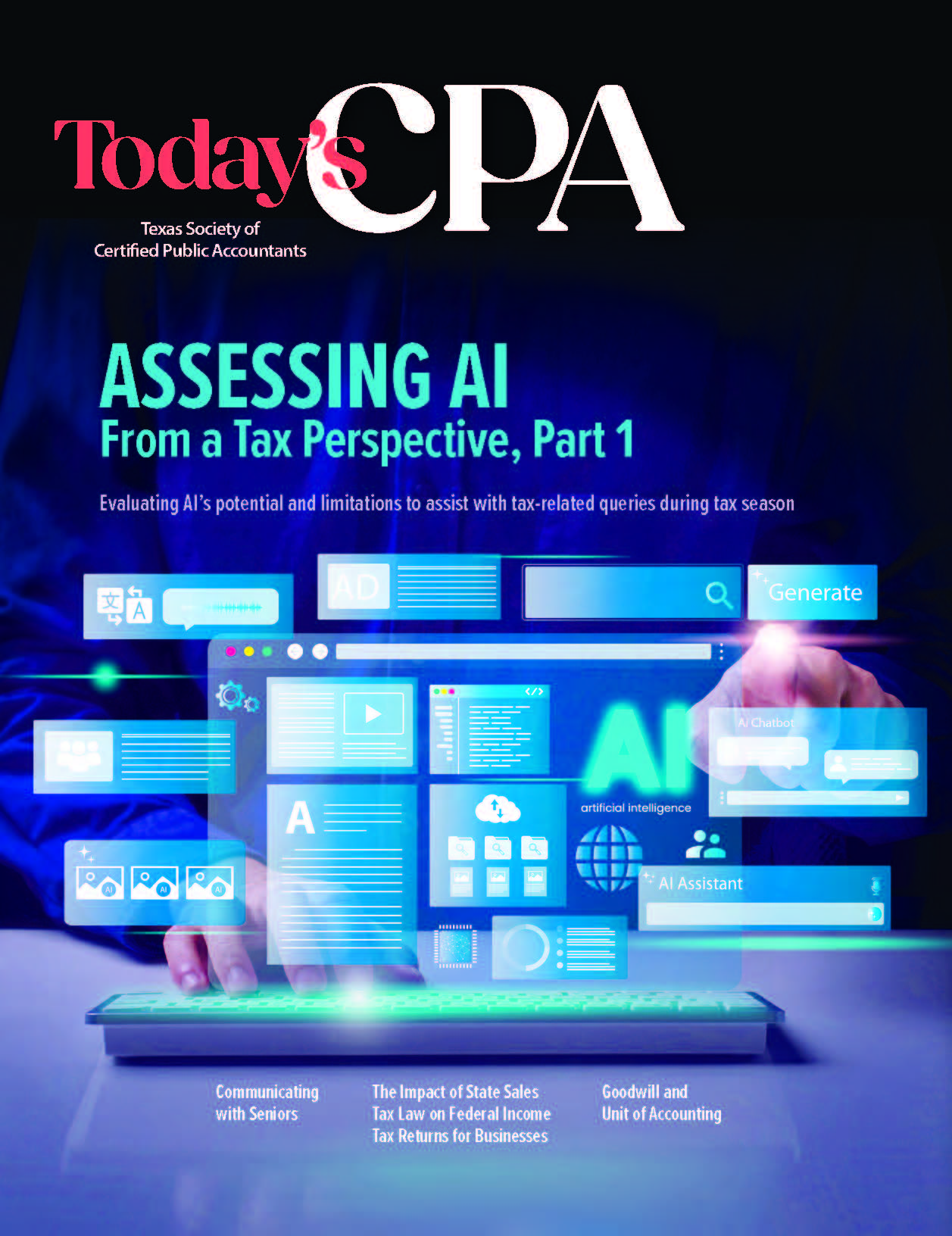January 15, 2025
CPE: Goodwill and Unit of Accounting
By Josef Rashty
~~ ~~ ~~ ~~ ~~ ~~ ~~ ~~ ~~ ~~ ~~ ~~ ~~ ~~ ~~ ~~ ~~ ~~ ~~ ~~
CPE Self Study Article & Quiz Register to gain access to the self-study quiz and earn one hour of continuing professional education credit by passing the quiz.
~~ ~~ ~~ ~~ ~~ ~~ ~~ ~~ ~~ ~~ ~~ ~~ ~~ ~~ ~~ ~~ ~~ ~~ ~~ ~~
CPE Hours: 1
Curriculum: Accounting and Auditing; Management
Level: Basic
Designed For: CPAs in business and industry and public practice
Objectives: To describe and explain FASB's definition of goodwill and the alternatives available to assign acquired goodwill to different "units of accounting" within an organization
Key Topics: Unit of accounting; pushdown accounting; subsidiary acquisitions; tax implications; goodwill impairment; and disposal of unit of accounting
Prerequisites: None
Advanced Preparation: None
~~ ~~ ~~ ~~ ~~ ~~ ~~ ~~ ~~ ~~ ~~ ~~ ~~ ~~ ~~ ~~ ~~ ~~ ~~ ~~
ASC 350, Intangibles–Goodwill and Other, defines goodwill as “an asset representing the future economic benefits arising from other assets acquired in a business combination that are not individually identified and separately recognized.” In other words, goodwill is the excess amount that an acquirer is willing to pay over the fair value of the acquired reporting unit (acquiree) from the perspective of an appropriate market participant.
The following is an excerpt from Microsoft's Form 10-Q for the quarterly period ended March 31, 2023:
“Goodwill was assigned to our Intelligent Cloud segment and was primarily attributed to increased synergies that are expected to be achieved from the integration of Nuance. None of the goodwill is expected to be deductible for income tax purposes.”
This excerpt refers to “increased synergies” and Microsoft claims that it plans to achieve this synergy through its business combination. If it fails to do so, the recorded goodwill may be subject to impairment.
This article expounds on FASB's definition of goodwill and the alternatives companies may have on assigning their acquired goodwill to different "units of accounting" within their organization. The unit of accounting impacts goodwill impairment and has tax implications.
Unit of Accounting
FASB defines the unit of accounting as follows:
all goodwill acquired in a business combination shall be assigned to one or more reporting units as of the acquisition date. Goodwill shall be assigned to reporting units of the acquired entity that are expected to benefit from the synergies of the combination even though other assets or liabilities of the acquired entity may not be assigned to that unit. The total amount of acquired goodwill may be divided among a number of reporting units. (ASC 350-20-35-41)
If a company, as a result of an acquisition, assigns the goodwill to more than one reporting unit, ASC 350-20 requires that it uses a supportable and consistent methodology for the allocation of goodwill to different units of accounting.
Companies may also recognize goodwill as a whole instead of particular reporting units. Under this circumstance, the excess of the fair value of the net assets of the reporting units over their reporting net assets comprises the entity-level goodwill.
Entity R (the acquirer) acquires Entity E (the acquiree) through a business combination and creates $100 goodwill. If Entity E consists of two independent units of E1 and E2, Entity R may allocate the $100 goodwill under either of the following scenarios:
1. Entity R reflects the entire $100 as an entity-level goodwill at Entity R books.
2. Entity R elects to pushdown the $100 goodwill (in 1 above) to Entity E's books.
3. Entity R reflects the $100 as Entity E goodwill.
4. Entity E, in turn, elects to pushdown the goodwill (in 3 above) to entities E1 and E2 books, if the circumstances permit.
5. Finally, Entity R identifies and assigns $70 goodwill with Entity E1, and the remaining $30 with Entity E2.
After recording goodwill as part of a business combination, public business entities (PBEs) test goodwill, at least annually, at a reporting unit level for any impairment.
Pushdown Accounting
Pushdown accounting requires that acquirees adjust the carrying amounts of the assets and liabilities in their financial statements to reflect the acquisition fair value adjustments that the acquirer has reflected in its consolidated financial statements as of the date that it has obtained the control of the acquiree. Pushdown accounting implies replacing the historical basis of accounting in the predecessor’s books with the new fair value basis in the successor’s books; thus, the acquiree cannot combine before and after the date of pushdown. The successor financial statements reflect the predecessor’s retained earnings account into its additional paid-in capital (APIC).
Acquirees elect pushdown accounting for various reasons, such as spin-offs, regulatory requirements or compliance with debt covenants. It may also be advantageous to apply pushdown accounting for tax purposes, depending upon the tax jurisdiction of the acquiree.
An acquiree recognizes goodwill due to a change in control and application of pushdown accounting. If the acquirer recognizes any bargain purchase gains, the acquiree reflects it as an adjustment to additional paid-in-capital rather than a bargain purchase gain. If the acquiree is a PBE, the goodwill is subject to an annual impairment test under ASC 350-20 at a reporting unit level.
However, private companies and not-for-profit acquirees can elect an alternative to amortize goodwill on a straight-line basis over 10 years or less if another useful life is more appropriate (ASC 350-20-35-63).
When there is a change-in-control event, an acquiree has the option to apply pushdown accounting. The acquiree must make the election to apply pushdown accounting before issuing its financial statements (for SEC registrants) or when the financial statements are available (for non-registrants).
If the acquiree elects to apply the pushdown accounting option, it should do so as of the acquisition date (ASC 805-50-25- 6). Any subsidiary of an acquiree is also eligible to apply pushdown accounting, irrespective of the acquiree’s decision to elect pushdown accounting (ASC 805-50-25-8). However, once the acquiree or its subsidiaries adopt the pushdown accounting option, the election they have made is irrevocable.
The following example clarifies the pushdown goodwill.
Entity R acquires Entity E for $1,000 and reflects $100 as goodwill. Entity E elects pushdown accounting. Table 1 reflects the financial statements of Entity E before and after pushdown accounting.
| Table 1. | |||
| Balance Sheet | Prior to Pushdown | Fair Value Adjustments | After the Pushdown |
| Assets | $600 | $300 | $900 |
| Goodwill | $0 | $100 | $100 |
| Total assets | $600 | $400 | $1,000 |
| Liabilities | $200 | $0 | $200 |
| Retained earnings | $50 | ($50) | $0 |
| APIC | $350 | $450 | $800 |
| Total liabilities and equity | $600 | $400 | $1,000 |
Subsidiaries’ Acquisitions
A company’s consolidated subsidiary may acquire another entity in a business combination. If so, the subsidiary should reflect all the goodwill resulting from the acquisition in its separate financial statements, regardless of the amount of the goodwill the parent company assigns to the reporting unit.
For example, in the earlier illustration, Entity E may acquire another entity and reflect a goodwill of $100 in its separate financial statements. Entity A reflects this goodwill in its consolidated financial statements even though goodwill is in Entity E’s separate financial statement. Entity E also reflects any goodwill impairment charges related to this acquisition in its books and these charges also appear in the consolidated financial statements of Entity A.
Tax Implications of Goodwill Acquisition
The income tax consequences of a business combination follow one of three patterns:
- A taxable transaction, where the acquirer takes a fair value tax basis in the net assets acquired;
- A nontaxable transaction, where the acquirer takes a carryover basis in the net assets but a fair value basis in any acquired stock;
- A nontaxable exchange, where the acquirer takes a carryover basis in both the net assets and the acquired stock.
The tax treatment of an acquisition may directly or indirectly affect the price of the transaction, and thus, the amount of goodwill and its future possible impairment, since an acquirer might be willing to pay more for an acquisition in a taxable transaction if such transaction can provide a step-up in the tax basis of the acquired net assets. Furthermore, the structure of an acquisition also dictates whether an acquirer can benefit from the existing tax attributes (e.g., tax credit carryforwards and net operating loss) of an acquiree.
Goodwill Impairment
In January 2017, FASB issued Accounting Standards Update (ASU) 2017-04, Intangibles–Goodwill and Other (Topic 350): Simplifying the Test for Goodwill Impairment. This guidance simplified the goodwill accounting compared to its predecessor standard.
ASU 2017-04 eliminated the calculation of implied goodwill fair value by abolishing the earlier two-step impairment testing process; instead, under this ASU, companies record impairment charges based on the excess of a reporting unit’s carrying amount over its fair value. Thus, companies record goodwill impairment charges if, and only if, a reporting unit’s carrying value exceeds its fair value.
Companies must perform the simultaneous impairment test of their goodwill and other long-lived assets (held and used) in a particular order.
If goodwill and another asset (or asset group) of a reporting unit are tested for impairment at the same time, the other asset (or asset group) shall be tested for impairment before goodwill. For example, if a significant asset group is to be tested for impairment under the Impairment or Disposal of Long-Lived Assets Subsections of Subtopic 360-10 (thus potentially requiring a goodwill impairment test), the impairment test for the significant asset group would be performed before the goodwill impairment test. If the asset group was impaired, the impairment loss would be recognized prior to goodwill being tested for impairment. (ASC 350-20-35-31)
In June 2022, FASB halted a four-year effort to revamp how companies account for goodwill, with some board members indicating that the case made for a revision was not strong enough to justify an overhaul.
Companies that do not meet the definition of PBEs, ASU (2013-12), Definition of a Public Business Entity, can potentially amortize their goodwill on a straight-line basis over 10 years or less. The guidance eliminates the test for goodwill impairment annually by requiring the test only when an event or circumstance indicates that the fair value of the entity (or reporting unit) may be less than the carrying value.
Companies must perform the simultaneous impairment test of their goodwill and other long-lived assets (held and used) in a particular order. For example, before testing of goodwill for impairment, companies should test other assets in an order: accounts receivable, inventory and indefinite-lived intangible assets, then long-lived assets (including definite-lived intangible assets), and finally, goodwill. They should record any impairment for each group of assets before proceeding to the next test. (ASC 350-20-35-31)
Tax Implications of Goodwill Impairment
Cost of goodwill impairment (for PBEs) or amortization (for private companies) for financial accounting purposes may exceed cost of goodwill amortization for tax purposes. If so, they may increase their deferred tax assets (DTAs) or decrease their deferred tax liabilities (DTLs) related to their tax-deductible goodwill.
Under ASU 2017-04, companies recognize an impairment charge to the extent that the carrying value of a reporting unit exceeds its fair value (not to exceed the carrying value of goodwill). To determine the unit's fair value, companies determine whether the hypothetical sale has occurred in a taxable or nontaxable transaction. This determination affects the unit's fair value and any future goodwill impairment charges.
In certain jurisdictions, goodwill amortization and write-downs are tax deductible. If a company or reporting unit operates in these jurisdictions, goodwill impairment charges may decrease its DTL or increase its DTA. A decrease in DTL or an increase in DTA causes an immediate increase in the carrying value of the reporting unit that may cause additional impairment charges (ASC 350-20-35-20 & 21 and ASC 850-740-25).
ASU 2017-04 addressed this issue and requires an entity to calculate the impairment charge and the deferred tax effect simultaneously (similar to how an entity calculates goodwill and the related DTAs in a business combination).
For example, if a company has goodwill impairment charges of $1,000 (the excess of the carrying amount of reporting unit over its fair value) and its effective tax rate is 20%, the result of impairment on the carrying value of goodwill is $200 [$1000 − ($1000 × 20%)]. However, if this company uses simultaneous equations (based on the new guidance), the result of impairment on the carrying value of goodwill is $250 [20% divided by (1 – 20%)] × $1,000] (ASC 350-20-55-23 C & D).
Table 2 reflects the impairment of tax-deductible goodwill prior to simultaneous calculation.
| Table 2 | Fair Value of Reporting Unit | Goodwill Impairment | Deferred Tax Adjustment | Carrying Value After Adjustment |
| Goodwill | $10,000 | ($1,200) | $8,800 | |
| DTL | ($2,000) | $250 | ($1,750) | |
| Other assets | $50,000 | $50,000 | ||
| Total | $58,000 | ($1,200) | $250 | $57,050 |
In Table 2, the carrying value of the reporting unit (57,050) does not reflect the full impact of the $1,000 impairment.
Table 3, on the other hand, reflects the impact of goodwill impairment on the carrying value of reporting unit according to ASU 2017-04 simultaneous calculation.
| Table 3 | Fair Value of Reporting Unit | Goodwill Impairment | Deferred Tax Adjustment | Carrying Value After Adjustment |
| Goodwill | $10,000 | ($1,250) | $8,750 | |
| DTL | ($2,000) | $250 | ($1,750) | |
| Other assets | $50,000 | $50,000 | ||
| Total | $58,000 | ($1,250) | $250 | $57,000 |
Table 4 reflects the carrying value of goodwill and reporting unit when goodwill assigned to the reporting unit is not tax deductible.
| Table 4 | Fair Value of Reporting Unit | Goodwill Impairment | Deferred Tax Adjustment | Carrying Value After Adjustment |
| Goodwill | $10,000 | ($1,000) | $0 | $9,000 |
| DTL | ($2,000) | $0 | ($2,000) | |
| Other assets | $50,000 | $50,000 | ||
| Total | $58,000 | ($1,000) | $0 | $57,000 |
Thus, the excess tax deduction over financial reporting deduction generally results from lower tax liability. The difference in the basis creates temporary difference that results in DTL.
Disposal of Unit of Accounting
When an entity disposes of its entire unit of accounting, it includes in the reporting unit’s carrying amount the goodwill of that unit of accounting in determining the gain or loss on disposal. When an entity disposes some, but not all, of a reporting unit, the accounting for that reporting unit’s goodwill will depend on whether the net assets of the disposed unit constitute a business. If the unit sold is not a business, the entity does not attribute goodwill to it.
If, on the other hand, the disposed net assets constitute a business, the entity should attribute a portion of the reporting unit’s goodwill to that business in determining the gain or loss on the disposal of the business. According to ASC 350-20-40-3, the entity attributes the amount of goodwill based on the relative fair values of (1) that business and (2) the portion of the reporting unit it retains.
Final Remarks
Companies assign the acquired goodwill to specific units of accounting for purposes of the annual or interim impairment assessment; therefore, identification of entity's units of accounting, the determination of the amount of goodwill, and the method of the goodwill impairment testing or amortization may have significant financial impact.
An acquiree may recognize goodwill due to a change in control and application of pushdown accounting. Pushdown accounting is irreversible and exposes the company to goodwill impairment if the fair value of the unit that reflects goodwill falls beyond a certain threshold.
The tax treatment of an acquisition may directly or indirectly affect the price of the transaction and thus, the amount of goodwill and its future possible impairment. The tax jurisdiction of goodwill's unit of accounting may also have an impact on its impairment and tax calculation (including the amount of DTA and DTL).
In summary, identifying goodwill’s unit of accounting may impact the tax position and goodwill impairment charges and require significant management judgment. The author recommends that companies work with their tax professionals at the early stages of each acquisition to structure the formation of any goodwill acquisition. The tax department often needs to maintain a different set of books to reflect goodwill, goodwill amortization, DTAs, and DTLs. Tax professionals should weigh in on the taxability of the jurisdictions, the tax rates and ultimately financial impacts.

In March 2024, the SEC promulgated its new climate-related disclosure rules for PBEs. Companies may incur significant expenses and capital expenditures to control greenhouse emissions in their business units. These expenses may adversely affect the fair value of some of their units of accounting and trigger goodwill impairment.
About the Author: Josef Rashty, CPA, Ph.D. (Candidate), is a member of the Texas Society of CPAs. He provides consulting services and serves as a faculty member at several institutions and universities in Silicon Valley, California. He can be reached at j_rashty@yahoo.com.
Thanks to the Sponsors of Today's CPA Magazine
This content was made possible by the sponsors of this issue of Today's CPA Magazine:
















